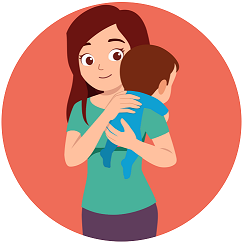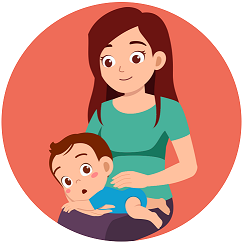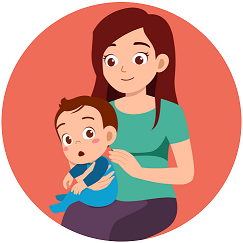
The joys of parenthood start at baby’s first breath, and as you breastfeed or bottle-feed your little one and progressively start them on solids, the joy continues with all the new milestones. It’s a whole new and exciting adventure. Like learning about baby’s sleep needs, health checkups and clothing essentials, it is also essential to ensure that you get all the necessary tools and tips for feeding your baby. In addition to formula types, breastfeeding positions and proper breastmilk storage, learning about burping techniques is just as important when it comes to baby’s digestion and eating habits.
The Importance of Burping Baby After Feedings
So, why do you need to burp your baby? As baby is eating or breastfeeding, they inevitably swallow air in the process. The air then gets trapped in their stomach and can cause discomfort. In addition, digestive breakdown of certain foods in the intestine can naturally create gas build up and nipple flow that is too advanced for baby may release food too quickly causing baby to guzzle and swallow too fast. The only way to ensure that the baby is comfortable and doesn’t spit up or even vomit due to air buildup and digestion discomfort is to burp him/her to rid their stomach of the excess air bubbles.
 While burping is typically assumed to be done after baby has eaten, some signs baby gives may warrant you to burp your baby mid-feeding. When bottle feeding, either with formula or offering expressed breast milk, you’ll want to burp baby after every two to three ounces of milk, or more often if baby seems fussy or slow to drink. When breastfeeding, a good practice is to burp baby each time he/she switches breasts.
While burping is typically assumed to be done after baby has eaten, some signs baby gives may warrant you to burp your baby mid-feeding. When bottle feeding, either with formula or offering expressed breast milk, you’ll want to burp baby after every two to three ounces of milk, or more often if baby seems fussy or slow to drink. When breastfeeding, a good practice is to burp baby each time he/she switches breasts.
It should be noted however that some babies may not need to burp as often, especially if they have not swallowed much air while feeding. In cases where baby hasn’t burped after some time, continue feeding as normal since baby may not burp every time you try.
It’s important to know that there is no specific length of time needed for burping your baby. The important part of this practice is providing baby with regular burping sessions frequently throughout feeds to provide ample opportunity to clear unwanted air from the tummy.
Likewise, if your baby shows any signs of being gassy, spitting up, acting fussy during feedings, or if he/she has been diagnosed with gastroesophageal reflux disease (GERD), it may be a good opportunity to plan on burping him/her more regularly or try then and there.
Like every other aspect of raising a child, every baby is unique, so there is no specific time, interval or length for when you should burp them. Instead, it is best to learn your baby’s patterns over time and find a timing and method that works best for your child, whether a few minutes after eating or a few times throughout the process. Additionally, it is often helpful to keep baby in an upright position for 10 to 15 minutes after feeding, as this can help prevent him/her from spitting up.
In addition to timing, finding the right technique and position for burping your baby can be a helpful and effective bit of insight.
Common Positions for Burping Your Baby
 This is the most common and effective way to relieve your baby of built up air bubbles. For this position, hold your child upright and let their chin rest above your shoulder. Place one hand under their bottom to support them and with the other hand, gently rub and pat the baby alternatively. Do not forget to place a cloth over your shoulder to catch any spit-up.
This is the most common and effective way to relieve your baby of built up air bubbles. For this position, hold your child upright and let their chin rest above your shoulder. Place one hand under their bottom to support them and with the other hand, gently rub and pat the baby alternatively. Do not forget to place a cloth over your shoulder to catch any spit-up.
Sometimes the over-the-shoulder technique may take a long time depending on the baby, so you can sit in a rocking chair or lightly bounce your legs while sitting, as the added motion may help speed things along and relax baby. Wait a few minutes after feeding to move baby around too much during burping, as doing it too soon after eating may make them throw up.
 When burping baby in this position you want to ensure that the baby’s head is placed sideways on one of your laps and baby is facing their stomach downwards. It can also help if you raise their head just slightly higher than the rest of their body. You will then ever so slightly tap your fingers or rub their back until they burp, keeping in mind that it may take up to five minutes to see any results. It is recommended to stop tapping their back after the first five minutes; if they don’t burp, rest for a minute, then repeat the process.
When burping baby in this position you want to ensure that the baby’s head is placed sideways on one of your laps and baby is facing their stomach downwards. It can also help if you raise their head just slightly higher than the rest of their body. You will then ever so slightly tap your fingers or rub their back until they burp, keeping in mind that it may take up to five minutes to see any results. It is recommended to stop tapping their back after the first five minutes; if they don’t burp, rest for a minute, then repeat the process.
 This technique is better for toddlers who have recently been introduced to solid foods at around six months old. This is because babies younger than this do not have the best head control and support, making the process much more difficult. For older toddlers, begin by sitting him/her on your lap with their face away from you. Put your hand on their chest and spread your fingers across their chin to support their neck and head, being careful not to touch their throat, which may obstruct their breathing. Lean your baby slightly forward at an angle and alternatively pat and rub their back tenderly.
This technique is better for toddlers who have recently been introduced to solid foods at around six months old. This is because babies younger than this do not have the best head control and support, making the process much more difficult. For older toddlers, begin by sitting him/her on your lap with their face away from you. Put your hand on their chest and spread your fingers across their chin to support their neck and head, being careful not to touch their throat, which may obstruct their breathing. Lean your baby slightly forward at an angle and alternatively pat and rub their back tenderly.
Walking is a great way to move trapped air bubbles, as any adult who has had indigestion can attest, and babies are no different. It is important to note that this method is recommended for older babies who can hold their head up without your support. Hold the baby upright with them facing forward as you walk. Use one of your hands to hold them under their bottom while the other hand mildly rubs their tummy. You can walk with your baby in this position or come down to floor level and help baby with walking motions of their own.
When breast or bottle feeding, it is advised to burp your baby regularly during and after their feeding to ensure that there is little to no air trapped, and the baby is full on what they are eating instead of guzzling in air. Regardless of how often you end up burping your baby remember that not all infants need to be burped as some will do it on their own while others will pass gas, and thus burping will not be necessary. If your baby doesn’t show any signs of distress associated with lack of burping, don’t be alarmed, simply be grateful that he/she is enjoying their food and feeling good.


